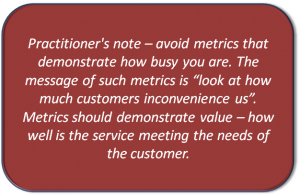Like it or not, customers evaluate IT on two things: How well you fix things that break, and how well you get me things I need. This article focuses on making happy customers through Basic IT Request Fulfillment.
Incidents and Requests
Incidents and Requests are often lumped together in the Service Desk as “calls” or “tickets”. And to some degree, they are both very similar – but Requests tend to get lost among the urgency of Incidents, and the result is unhappy customers.
How are the two different?
Incident – an unplanned interruption to a service. (something was or should be working but is not.) Check out What is Basic IT Incident Management for more details
Request – customer requires a service they currently do not have. Request are often for small changes that are done frequently and have low risk. Things like access to a resource, applications or server – new or replacement computer hardware, mobility, and remote access tokens.
A quick analogy.
A flat tire is an Incident – driving along just fine, then suddenly, a flat tire. When you call the tire store to come fix it, they are doing Incident Management. Your main concern is how quickly they get it fixed and you back on the road. You have better things to do than deal with flat tires.
On the other hand, when you go to the tire store for new tires, you are dealing with Request Fulfillment. You select from available choices for tires that meet your needs and budget, and come in the right size for your car.
Pretty straight forward, right?
Lets take a closer look.
Being stranded on the side of a busy road is both frustrating and dangerous. It is also preventing you from getting where you’re going.
A spare tire is a great Workaround to the Incident, because it gets you rolling again pretty quickly. But its only a temporary solution. The primary goal here is to get safely back on the road so you can accomplish your mission.
That’s the heart of Incident Management – Rapid recovery.
But to fully resolve the Incident, you need to come into the tire store and have the flat fixed and put back on the car. If the tire is fixable, it’s a pretty quick fix and you’re good to go.
But what if the tire is so bad that it has to be replaced?
Process wise, everything changes.
The repair guy hands you off to a sales guy who starts showing you new tire options. You start discussing price and tread warranty.
You’ve now entered the Request Fulfillment process. The goal now is to determine your needs and help you select from available options. And then get you set up and back on your way.
What is the Goal of Request Fulfillment?
Request Fulfillment is all about getting customers the IT Services they need to do their jobs.
It includes:
- Provide a single, consistent process through which customers can get access to standard services
- Improve customer satisfaction through timely and efficient processing of requests
- Answer questions and assist customers in selecting the right services.
- Coordinate the provisioning of services, and ensure customer is happy and able to use the service.
Basic Request Fulfillment Process
Requests come in from many sources – email, phone calls, walk-ups, etc. Regardless of source, the first step is always to determine of it’s an Incident or Request. At the most basic level, if something is no longer working – it’s an Incident. If the customer needs something they don’t currently have – it’s a Request.
- Determine if it’s a request. (If not, go to the Incident process)
- Gather basic customer contact information
- Understand customer needs and assist with selecting appropriate Service
- Establish priority, and set customer expectation for fulfillment time frame.
- Track status of requests.
- Validate the customer is authorized for request
- Is customer authorized for requested service?
- Has financial approval been granted? (if applicable)
- Coordinate service provisioning with appropriate provider(s)
- Follow up with customer when work is complete to ensure they have the service they need, and are able to use it successfully.
Many Service Requests are fulfilled by Service Desk staff (new email/network accounts, or network access requests), or in coordination with other back end teams (e.g. Security, Network) To ensure a high level of service, Request Fulfillment needs a single owner. In most organizations this is the Service Desk.
Requests are tracked from beginning to end to ensure delivery time commitments are met. The Service Desk must carefully monitor and escalate any requests that are in danger of missing Service Level expectations.
What Gets Measured Gets Done
Measuring the effectiveness of the Request Fulfillment process is important to ensure customer needs are being met.
To ensure efficient and timely fulfillment, consider measuring:
- Fulfillment time by Request type
- Percentage of request completed in agreed time frame
To measure Customer Satisfaction, consider:
- Customer survey feedback on requests
- Incidents caused by Request Fulfillment process
Of course, these are just suggested process metrics. I’m a strong believer in keeping your  service metrics few and to the point. You must understand your organization’s requirements and establish metrics that measure what’s important.
service metrics few and to the point. You must understand your organization’s requirements and establish metrics that measure what’s important.
Getting Started
You can have the best IT services in the world, but if your customers don’t know how to get them, or find the process cumbersome and inefficient, they will say you provide poor service.
How service requests are managed has a huge impact on how customers perceive IT service delivery. The good news is, Basic IT Request Fulfillment is one of the easiest IT process to get started.
- Establish clear ownership for Request Fulfillment (Service Desk).
- Build solid working relationships with all groups involved in provisioning of services.
- Use the steps above as a guide to a basic process, and get started delivering excellent customer service.
Photo Credit: Bjørn Giesenbauer via Compfight cc

Dikke 10 voor deze nigga die dit geschreven heeft. erg nuttig!